
 |
Home | Annapurna Main | Contact |
Updated: January 2012. Click on an image to see the FULL size with a caption.
The following reference information is included:
My rating scale:
 Excellent ;
Excellent ;
 Very Good ;
Very Good ;
 Good ;
Good ;
 Fair ;
Fair ;
 Poor.
Poor.
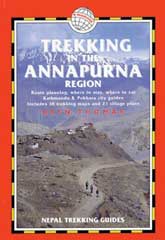



by Bryn Thomas. This is a great trekking book - the maps are especially detailed and accurate.

by Stan Armington. A classic trekking book detailing with very good maps and excellent route descriptions all of the favourite Nepalese treks, including Gokyo and Everest, Annapurna, Kangchenjunga, Annapurna, and Mustang.

by Pantha S Banerjee. This trekking book dedicated to the Annapurna Circuit and Sanctuary has excellent detailed maps and route descriptions. I especially like the many very good colour photos.
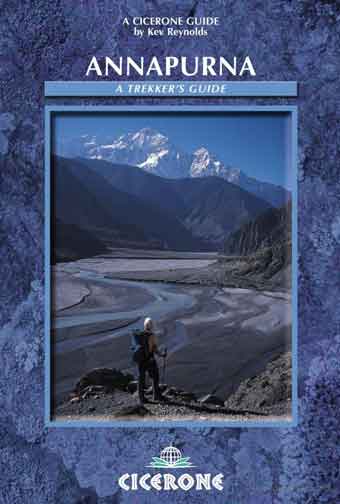
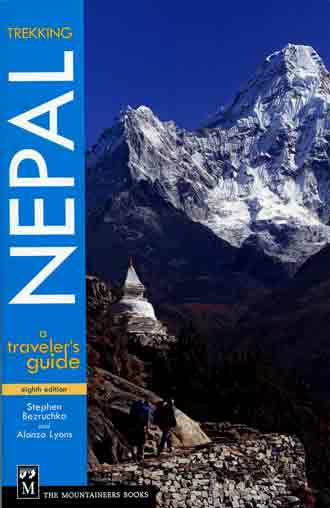


by Kev Reynolds. Kev has written some of my favourite trekking books. I've even learned that the timings he gives for each trek segment is exactly the time it takes me. The book features very good descriptions of the treks, great photos, but the maps are not very good. There are no village maps.

by Stephen Bezruchka and Alonzo Lyons. This book contains detailed route descriptions of the Annapurna Sanctuary and Circuit, Gokyo and Everest, Makalu, Langtang, Gosainkund, Helambu, and some rare treks like Rara Lake. There are only a few maps that are basic overviews and not detailed. There are 16 pages of colour photos and many b/w photos. In addition to the normal Annapurna Sanctuary and Circuit, this book also describes the challenging trek to Annapurna North Base Camp and the trek to Tilicho Tal.

by Ian Johnson. This very small lightweight book by yetizone.com contains detailed day by day itineraries for the Annapurna Circuit and Sanctuary treks. Although there are no photos, there are very good drawings of some of the mountain views.



by Steve Razzetti. Published 2001. This book contains basic information on 25 treks in Nepal, including Humla to Mount Kailash, the Annapurna Sanctuary and Circuit, the Dhaulagiri Circuit, Jomsom to Mustang, Around Manaslu, Rolwaling, Gokyo and Everest, Makalu, and Kangchenjunga. It also contains descriptions of climbing 12 trekking peaks, including Pisang, Chulu, Ramdung, Lobuche East, Imja Tse, and Mera. The front cover is Annapurna South.
It includes five pages on the Annapurna Sanctuary including Tharpu Chuli (Tent Peak) trekking peak, six pages on the Annapurna Circuit including Pisang and Chulu East and Far East trekking peaks.
The trekking route descriptions and maps are basic. The photos are very good.
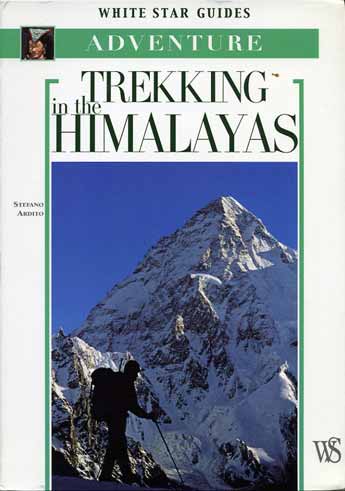
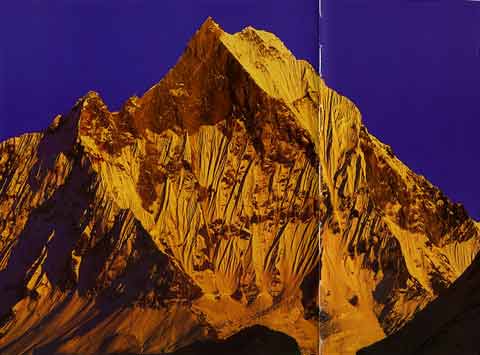

by Stefano Ardito. Good overview maps and photos along with basic descriptions of 15 treks, including 10 pages on the Annapurna Sanctuary, and 10 pages on Around Annapurna. The book features some excellent photos of Annapurna and Machapuchare.

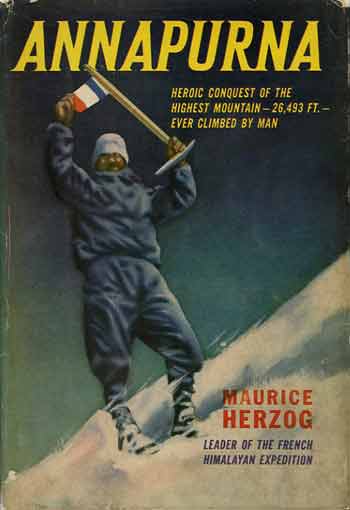
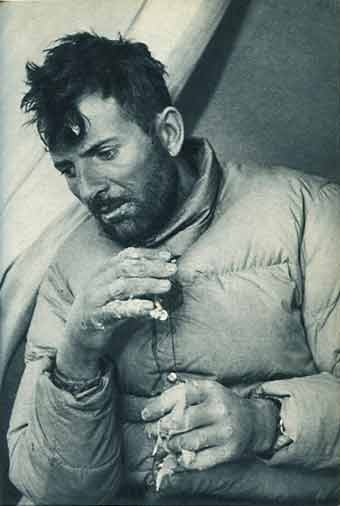

by Maurice Herzog. First published in English in 1952. My second favourite Mountaineering book of all time! One of Michael Chessler's Top 100 Mountaineering Books. This is the most widely-read and influential mountaineering book ever published. Annapurna was the first 8000m mountain to be climbed, with Herzog becoming a national hero. I have two versions of the book - New York 1953 (cover shown) and London 1952. Both books have 4 pages of colour photos, 24 pages of b/w photos, and an 8-page fold out map with a b/w photo. However, the New York book has 11 photos not in the London, and the London book has 10 photos not in the New York.
Because the maps at the time were incorrect, the team initially floundered looking for a route to either Dhaulagiri or Annapurna. Deciding that Dhaulagiri was too difficult, they found their way to the North Face of Annapurna. They quickly, and luckily, raced up the mountain. On June 3, 1950 Maurice Herzog and Louis Lachenal reached the summit of Annapurna without oxygen.
The descent turns into a nightmare, and is better than any fictional writer could dream up. Herzog loses his gloves and his hands become frostbitten and Lachenal's feet become frostbitten. Both barely make it back to camp. Lionel Terray and Gaston Rebuffat help them, but the weather turns into a white-out. They wander around helplessly before finding a crevasse to spend the night. They were caught in an avalanche. The medical treatment they received by the expedition doctor was unbelievable and almost primitive.
"The summit was a corniced crest of ice, and the precipices on the far side which plunged vertically down beneath us, were terrifying, unfathomable. Our mission was accomplished. But at the same time we had accomplished something infinitely greater. How wonderful life had become! What an inconceivable experience it is to attain one's goal and, at the very same moment, to fulfill oneself. I was stirred to the depths of my being. Never had I felt happiness like this - so immense and yet so pure."
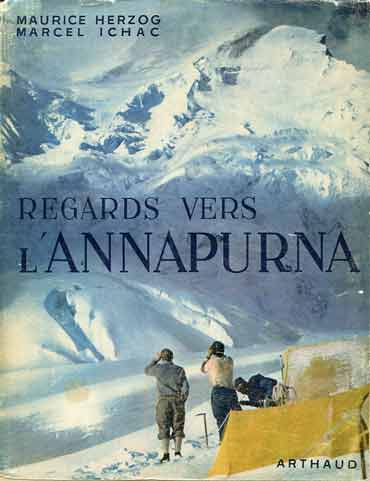
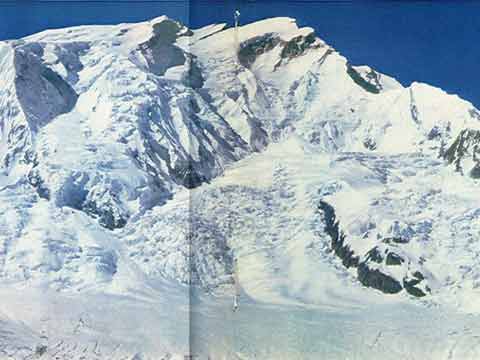


Most photos by Marcel Ichac, text by Maurice Herzog. Published 1951. In French. Medium-sized soft cover photo book of the 1950 French expedition that made the first ascent of Annapurna. There are many photos not in Maurice Herzog's book Annapurna. There is a folding map of the area included. There are 13 colour photos and 71 b/w photos. The cover is Annapurna North Face.
Photos include Kathmandu, the trek in, trying to find a route for Dhaulagiri, crossing Tilicho Lake to Manang and returning via Muktinath and Jharkot, the climb of Annapurna North Face and the evacuation and return.
This is a perfect companion book to Maurice Herzog's Annapurna, providing many more photos to help you visualize the story. The photos are excellent. The text is brief.




by Lionel Terray. Published in English in 1963. One of Michael Chessler's Top 100 Mountaineering Books. An autobiography focusing on the second ascent of the Eiger North Face in 1947 and a dramatic rescue on the Eiger in 1957, and participating in the first ascent of Annapurna in 1950. There are brief stories of many of his climbs, including the Walker Spur of the Grandes Jorasses in 1946, the first ascents of Fitzroy and Huantsan in 1952, the first ascents of Chomolonzo in 1954 and Makalu in 1955. There are 84 pages of b/w photos.
There are 75 pages on Annapurna and 17 pages of b/w photos. Terray describes the first ascent of an 8000m peak by Maurice Herzog and Louis Lachenal on June 3, 1950 without oxygen. Writing in 1961, Terray ends the story by recounting the lives and deaths of the climbers since 1950.
"With his (Herzog) beard and his clothing all strangely coated in rime and his eyes shining, he told me of victory. I seized him by the hand ... I cried out: 'Momo, your hand is frostbitten!' ... Lachenal had obviously had a long fall. I found him hatless, gloveless, axeless and with only one crampon."
This is a good companion book to the Maurice Herzog's Annapurna. I really like the writing style, interesting and to the point. The photos are very good.
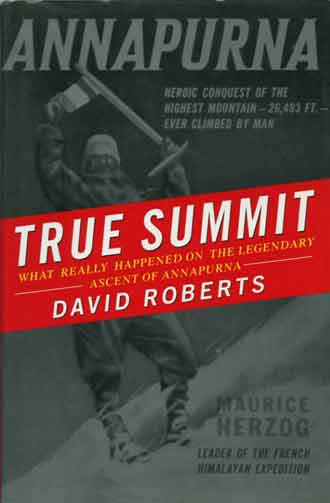



by David Roberts. Published 2000. The first ascent of an 8000m peak was made by Maurice Herzog and Louis Lachenal on June 3, 1950 when they reached the summit of Annapurna without oxygen. Maurice Herzog, the leader of the expedition, became a national hero in France, and Annapurna, his account of the historic ascent, has long been regarded as the ultimate tale of courage and cooperation under the harshest of conditions.
Just like Anatoli Boukreev's rebuttal of Jon Krakauer's Into Thin Air book on the 1996 Everest disaster, Roberts provides an alternate version of what happened on Annapurna in 1950. Using newly available documents and books published in France and an interview with Herzog, the author presents a different view of this classic tale. Instead of the harmony and cooperation from Herzog's book, Roberts shows the expedition being torn by dissent. He gives Lachenal, Lionel Terray and Gaston Rebuffat recognition for their achievement. There are 10 small b/w photos.
Can the expedition have been as harmonious as Herzog makes outs - no. Can it be as bad as Roberts makes out - no. The truth as usual is in the middle somewhere. What is for sure is that Herzog made it to the summit of Annapurna.
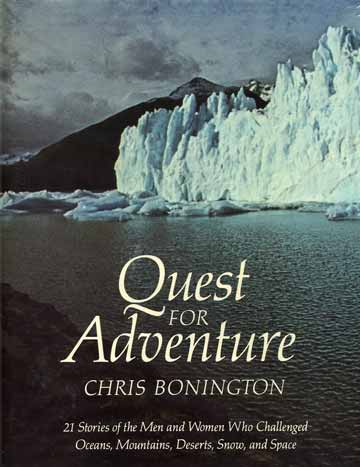



by Chris Bonington. Published 1981. The famed British mountaineer briefly describes 21 stories of adventure in 7 groups: 6 stories on Oceans, 1 on Deserts, 1 on Rivers, 7 on Mountains, 3 on The Poles, 1 on Air, 1 on Space, and 1 on Beneath The Earth. The mountains stories are the first ascents of Annapurna in 1950, Everest in 1953, Cho Oyu in 1954, and Broad Peak in 1957; Bonington's Annapurna South Face expedition in 1970, Reinhold Messner's solo ascent of Nanga Parbat in 1978, and Walter Bonatti's ascent of the Dru in 1955. There are 27 pages of colour photos, 31 pages of bw photos, 29 colour photos in line with text, 118 bw photos in line with text, 25 maps, and 10 mountain climbing routes.
The Annapurna chapter is 15 pages, with 3 colour photos and 6 bw photos in line with text, 1 page bw photo, 3 maps, and 1 climbing route. Bonington starts with an overview of that time just after the war: the French were just starting to move to the forefront of mountaineering, Nepal had just opened up but the maps were inaccurate, and the team and leader were selected by the French Alpine. "[Leader Maurice Herzog] had climbed with all the members of the team, and had the force of personality, combined with tact and sympathy, to co-ordinate the efforts of a group of individualists."
They started with a reconnaissance of Dhaulagiri, but decided it was too hard, and switched to try Annapurna. Time was running out before the monsoon would hit, but first they had to find a way to the foot of the Annapurna. Once there, they raced up the mountain, where [Herzog] "emerged as an extremely strong goer at altitude. The other driving force of the team was Lionel Terray, dogmatic, single-minded, immensely determined, not so much for himself, but for the expedition as a whole." But Terray got out of phase with Herzog, and "Terray's closest friend, [Louis] Lachenal, who teamed up with Herzog to climb up to the top camp. Lachenal, a volatile, impetuous personality, was always restless, at times wholly optimistic, he could also be easily depressed."
Bonington closes the story with a brief summary of the summit by Herzog and Lachenal on June 3, 1950, the descent, stumbling around in the storm, being rescued, and the harrowing walk out with amputations of frostbitten digits along the way. "It was undoubtedly a miracle that [Herzog, Lachenal, Terray, and Rebuffat] survived at all; there had been so many narrow escapes."
Bonington writes a brief and basic sanitized overview of the most dramatic story in mountaineering history. The photos, most from xxx book, are very good.



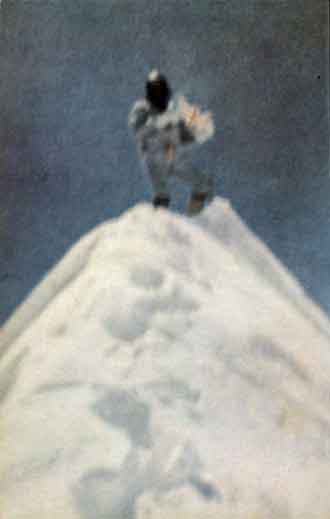

by Chris Bonington. First published 1971. One of Michael Chessler's Top 100 Mountaineering Books. The expedition leader tells the story of the famous climb of the massive South Face of Annapurna, with Haston's diary telling the story on summit day. There are 48 pages of colour photos. A fold-out page has a b/w photo with the ascent route and camps clearly marked. A short 18-page summary of the climb can be found in Quest For Adventure also by Chris Bonington.
Bonington put the importance of their climb perfectly: "Our ascent of Annapurna was a breakthrough into a new dimension of Himalayan climbing on the great walls of the highest mountains in the world - this represents the start of an era, not the end. Climbers will turn to other great faces, will perhaps try to reduce the size of the party, escape from the heavy siege tactics that we were forced to employ and make lightweight assaults against these huge mountain problems."
The climb was a logistical planning accomplishment and a real team effort. For example, Mick Burke tackled the rock band: "The rock now arched up into the vertical, there were no footholds and an icy armour encased every crack. ... Mick had run out two hundred feet of rope and had undoubtedly climbed the most exacting stretch of rock that we encountered on the South Face of Annapurna. ... The scale of everything was so huge - the glacier, the ice cliffs, the avalanches"
"Don and Dougal had a single-minded drive to get to the summit ... He (Don) picked a beautiful line through towards the summit ridge. The he disappeared over the ridge ... and suddenly it was calm. There was no wind on the north side." Dougal Haston and Don Whillans reached the summit on May 27, 1970. The climb ended in tragedy as they were leaving the mountain. Mick "looked up, face contorted with shock, grief and exhaustion. 'It's Ian (Clough). He's dead; killed in an ice avalanche below Camp II.' "
Although I find Bonington's writing style a bit straightforward and logistical, this is a very important climb in mountaineering history, and well worth the read. The photos are very good.




by Ed Viesturs, David Roberts. Published 2011. America's first mountaineer to climb all 14 8000m peaks and twelfth overall, all without oxygen, Viesturs describes the major events on Annapurna along with his own three attempts featuring his diary entries. You should buy this book first and foremost for Viesturs account of the first ascent of the East Ridge by Swiss Erhard Loretan and Norbert Joos in 1984, second for the miraculous survival of Simone Moro and tragic death of Anatoli Bookreev on Christmas Day 1997, third for his own three attempts and eventual success, and finally as a history of the main events in Annapurna's history including the first ascent by Maurice Herzog and Louis Lachenal in 1950, the first ascent of the south face by Dougal Haston and Don Willans on a Chris Bonington British expedition in 1970, the first ascent of the northwest face by Reinhold Messner and Hans Kammerlander in 1985, the first winter ascent by Jerzy Kukuczka and Artur Hajzer in 1987, and the second ascent of the east ridge by J.-C. Lafaille and Alberto Inurrategi in 2002. There are 8 pages of colour photos and a 2-page b/w photo.
The book starts with Ed describing his attempt to climb Annapurna North Face in 2000 with Veikka Gustafsson, Neil Beidleman, and Michael Kennedy. After witnessing "the biggest avalanche any of us had ever seen", they decided to give up their attempt because "the risks are too great."
Ed then describes the first ascent of Annapurna in 1950 by Maurice Herzog and Louis Lachenal, chronicled by Herzog in Annapurna, the best-selling mountaineering book of all time. In 2000, Ed's co-author for this book, David Roberts, wrote True Summit, a book fairly critical of Herzog, stating that the 1950 team was ridden with dissension, acrimony and envy, and that the book was little more than a gilded fairy tale. Ed disagrees with David: "For me, Annapurna is still an amazing book, essentially a true story, and all six of the leading climbers' ability to pull together to save one another's lives far outweighs the kinds of squabbles and disagreements David dug up." After searching for a route on Dhaulagiri, the French team switched their energies to Annapurna. Even though the maps of the day were wrong, the team managed to find a way to the Annapurna North Face, and in just a few days were ready to tackle the summit. Herzog was "indulging in the kind of ecstasy" and stayed on the summit while Lachenal wanted to go down. "As much as I admire Herzog and empathize with his rapture, I have to concede that Lachenal was using better judgment." He briefly describes the horror filled descent and escape from the clutches of death,
The authors then describe the first ascent in 1970 of the enormous Annapurna South Face rising "in one unbroken, gargantuan sweep more than 10,000 feet from the glacier at its base to the summit". Dougal Haston and Don Willans, "two brilliant climbers with huge egos, blazing ambition, and sharp tempers", reached the summit. The British Expedition was led by Chris Bonington who "despite his conservative, military background ... has always been a firm proponent of the tell-it-like-it-is school of adventure journalism." The lead climbers were supported by five "good soldiers", including Tom Frost who provides some perspective on the expedition. "For me, the day-to-day details, disputes and all, painted a complete and accurate picture of expedition life ... Despite the dissension within the team ... the ascent of the south face of Annapurna ranks today as one of the geatest deads in Himalayan history."
My favourite chapter is when Ed Viesturs tells the next story of the 1984 ascent of the East Ridge by Erhard Loretan and Norbert Joos. After a brief review of the 1978 ascent by an all-women's expedition led by Arlene Blum, Ed uses Loretan's book Les 8000 Rugissants to tell the story. The two Swiss climbers left Base Camp on October 21 and climbed to Camp II, and the next day to Camp IV at 7500m, a snow cave above Roc Noir. They set out on October 23 at 4:30, reached the Col below the East Summit at 8:30 and reached the East Summit at 14:00, descending in an hour to the col below the central summit at 8020m where they decided to bivouac in a snow cave. In a call to base camp they announced their intention of "descending by the north face after having reached the principal summit." Rather than what was believed to be a desperate last resort, Loretan and Joos had pre-planned to do the traverse of Annapurna. On October 24 they climbed the Central Summit and then had to rappel down a 100m rock cliff that blocked any idea of retreat along the East Ridge. They reached the main summit at 13:30. "We fell into each other's arms. A great happiness spread through me. ... The statistician in me told me that we had succeeded today on a new route on Glacier Dome (Tarke Kang), the third ascent of the Roc Noir (Khangsar Kang), and the first of the east ridge of Annapurna with its three summits (east, middle, and main) ... to celebrate ... it would be necessary to arrive on the north-side base camp alive, and that, as the one-armed say, is another pair of sleeves." After only 10 minutes on the summit, they started their descent of the north face which neither climber had seen before and bivouacked again at around 6800m. On October 25 the men spotted the top end of a fixed rope just 100m below them, but below an overhanging wall. "The descent of those 300 feet would turn out to be the most desperate passage of the whole traverse." After reaching the fixed rope, the two climbers continued their descent and had to bivouac again before stepping off the glacier at 13:00 on October 26. Loretan: "The doors of hell had just closed behind us, enclosing inside them our fears, our doubts and our anguish." Viesturs: "There is absolutely no doubt in my mind that the 1984 traverse of Annapurna was one of the greatest feats in Himalayan history."
In the next chapter, Ed detours to look at competition in mountaineering, specifically between Loretan and Benoit Chamoux to be the third person to climb all 14 8000ers. In September 1995 Both Loretan and Chamoux were on the south side of Kangchenjunga. Loretan arrived a little earlier and was more acclimitized and stronger than Chamoux. Loretan: "I understood that Benoit Chamoux was absolutely determined to beat me to the top." Both climbers left Camp IV (7800m) on October 5 with Loretan's team breaking trail, and Chamoux lagging behind. Loretan reached the summit at 14:35 and passed Chamoux still heading up as he climbed down. Chamoux was never seen again.
J.C. Lafaille and his mentor Pierre Beghin's attempted the south face of Annapurna in 1992, where Beghin fell to his death. "The ordeal he endured during the next several days would eventually become one of the most amazing self-rescues in mountaineering history." After attempts in 1995 and 1998, J.C. teamed up with Ed Viesturs and Veikka Gustafsson to try the East Ridge in 2002. "In Jean-Christophe Lafaille, I would discover one of the best partners of my mountaineering career." Alberto Inurrategi joined the climbing team. "In May a pattern began to form, with J.-C. doing most of the leading on our route. In part that was because he was so fast and so technically gifted." As J.-C. and Alberto pushed on the East Ridge, Ed "started getting the heebie-jeebies ... Deep snow on the face - not good. ... [Veikka and Ed] both agonized but finally after hours of silence knew we would go down." J.-C. and Alberto completed the East Ridge and reached the summit of Annapurna on May 16. J-C.: "There, at an altitude of 8,091 meters, a deep cry of joy, of liberation, came from the bottom of my lungs ... We held each other in our arms. I started crying, my emotions were so strong. Alberto clasped [Felix's] ice ax to his heart." They returned along the east ridge to safety, with J.-C.'s obsesssion with Annapurna finished, but with Ed still needing to climb Annapurna for his quest to climb all 14 8000ers.
Ed then describes the competition between Reinhold Messner and Jerzy Kukuczka to become the first person to climb all 14 8000m mountains. Messner and Hans Kammerlander climbed a new route with "delicate friction moves on rock slabs interspersed with steep snowfields" up the northwest face of Annapurna in 1985. Kukuczka and Artur Hajzer climbed the north face, reaching the summit in winter on February 23, 1987. Kukuczka: "it is impossible for a moment to get away from that bitter, penetrating frost, that takes away one's will and hope. ... We climbed on ice so hard that even the tips of our crampons could hardly penetrate it."
After briefly commenting on Anatoli Bookreev and his involvement in the 1996 Everest tragedy, Ed takes excerpts from Simone Moro's book Comet on Annapurna to describe Simone, Anatoli, and Dimitri Sobolev's attempt in December 1997 of "a line attacking the fiercely glaciated southwest flank of Annapurna, well to the left of all the south-face routes." After making slow progress in the terrible conditions, sinking in snow up to their waists, they went down the valley for some R&R before heading back up the mountain. Moro: "Above my head there was a terrifying, gigantic cornice of snow and ice stretching out like an ocean wave. Death was hanging right over our heads ... A fraction of a second later, a deafening roar announced the end of that gigantic cornice, and with it our lives. 'Anatoliiiiii ...' That desperate cry was all I could manage before the explosion of ice and rock started pouring down on me. ... After that there followed an interminable phase of bouncing, sliding, spinning around and round." It was 12:36 on Christmas Day, December 25, 1997. Miraculously Moro survived. Simone shouted to Anatoli and Demitri, but there was no answer. Simone himself was in a desperate situation and, with shades of J.-C. Lafaille, had to throw caution to the wind and descend off the mountain by himself.
Ed closes the book with his successful ascent of Annapurna with Veikka Gustafsson on May 12, 2005, completing his Endeavor 8000 project and becoming the 12 person to climb all 14 8000m peaks. They first acclimitized on Cho Oyu to reduce their time spent on Annapurna to an absolute minimum. Ed had to forego his summit attempt to help Jimmy Chin, sick with pulmonary edema, descend from their high camp (7070m), while Veikka reached the summit solo. They then turned their sights on the 1950 French route on the north face, "the least of all evils." With help from Silvio Mondinelli's Italian Expedition in using their fixed ropes, "It would mean that we could climb alpine style, having to traverse that dangerous face only once on the ascent." After waiting for the weather to clear, they left base camp on May 8 and climbed to Camp II. The next day, "we had to dash up and across what I called the Gauntlet, that frightfully exposed face down which in 2000 we'd seen the avalanches pour" to Camp III (6800m). "I was pretty wired - the culmination of an eighteen-year quest might come the next day." After waiting out May 10 and 11 due to high winds, the left for the summit early on May 12. "The scale of this upper north face was truly monstrous." "It was 2:00 P.M. Veikka and I hugged each other as tightly as we could, feeling clumsy with cold. My mind was racing. Oh my God! It's not just my fourteenth, it's Annapurna. ... We spent almost an hour on top. I wanted to savor every sweet moment of this."
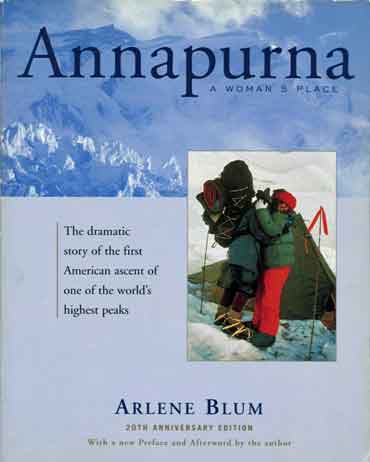
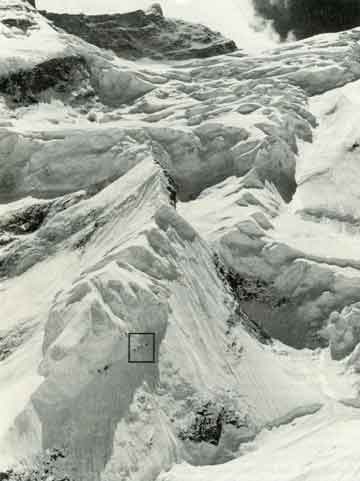
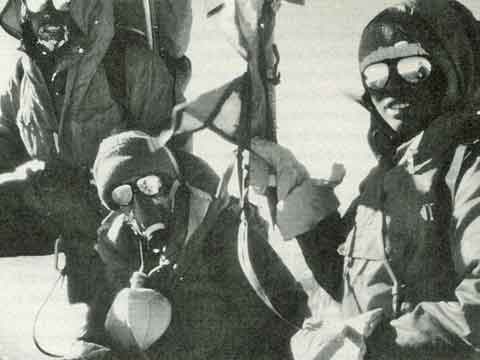

by Arlene Blum. First published 1980. One of Michael Chessler's Top 100 Mountaineering Books. The expedition leader tells the story of the 1978 American Woman's Himalayan Expedition to Annapurna I, which featured their famous t-shirt slogan "A Woman’s Place Is on the Top”.
The book follows the team of ten women climbers as they trek along narrow dangerous shepherd's paths to base camp with good scenery, meeting villagers, and treating porters for various health problems. There are brief profiles of each climber, scenes of smiling and camaraderie, and a surprisingly frank scene of dissent and painful conversations among the climbers. They establish camps on the North Face of Annapurna, ascend the steep and dangerous Dutch Rib, having to retreat twice due to storms and avalanches.
On October 15, 1978 Vera Komarkova, Irene Beardsley, Chewang and Mingma made it to the summit. Happiness quickly turned to tragedy when the second summit team Vera Watson and Alison Chadwick died the next day, falling on their way to Camp V.
Her writing style is honest and refreshing. She quickly gets into the action, and the pace throughout is good. She adds an immediacy to the story by using conversations among the team members. You can also buy the DVD of the climb.


by Andrew Stevenson. Published 1998. The author wrote a travelogue of his trek of the Annapurna Circuit and Sanctuary. He lets us know his inner thoughts and his challenges trekking including altitude sickness. He relays the conversations with his fellow trekkers and the local people he meets. He briefly describes the landscape enroute. He describes the basics of Buddhism, the main religion of the area.
"I deliberately listen to the sounds of the river, and the pad of my footsteps on the ground echoing my heartbeat. During the days my inner and outer beings are gradually falling into a rhythm; the dichotomy between spirit and body disappear. For the time being, there are no external schedules constraining me; no phones, no fax machines, no pagers, no memos, no mobile telephones to distract me from what I am doing. My own inner rhythm dictates my life."
This may be the best trekking travelogue every written. I enjoyed his writing style, honest, open, humourous, and insightful. I especially like the immediacy of his conversations with the people he meets, both trekkers and locals alike.
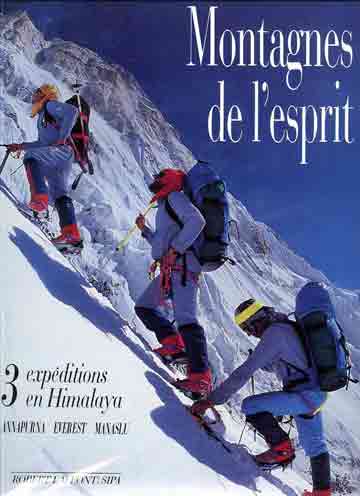



Photos by Pascal Tournaire and Marc Buscail, text in French and English by Marc Maisonneuve. Published 1989. This coffee-table photographic book documents three expeditions led by Benoit Chamoux - the successful ascent of the Annapurna South Face in 1988, the unsuccessful attempt to climb the Everest North face via the Hornbein Couloir in 1988, and the successful ascent of Manaslu via the south face to the west ridge in 1989. Chamoux was a superb French climber who summitted 13 of the 14 8000m peaks, before being killed in 1995 while attempting his 14th – Kangchenjunga. The front cover is Annapurna.
Chamoux and four other climbers climbed Annapurna using the south face, the route pioneered by Chris Bonington's British expedition in 1970. On May 10, 1988 Soro Dorotei is the first to reach the summit, followed by Josca Raconcaj, Steve Boyer, Nicolas Campredron and Chamoux.
The descriptions of the climbs are basic and brief. The photos are very good.

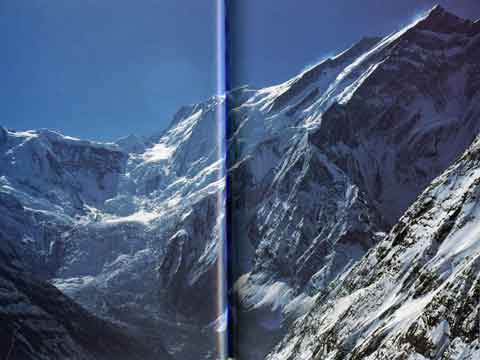
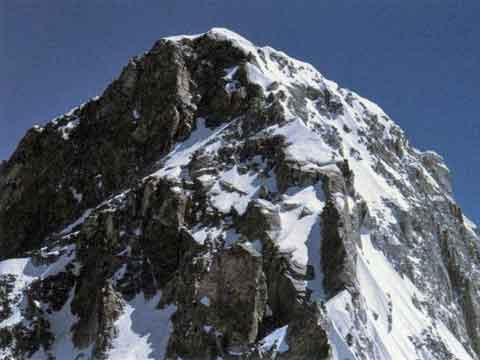

by Reinhold Messner. Published 2000. Messner reviews the significant climbs on Annapurna, especially the first ascent in 1950 and his own ascent of the Northwest Face. The front cover is Annapurna Northwest Face. There are 32 pages of colour photos and over 90 b/w photos.
He devotes the first half of the book to the first ascent by Maurice Herzog and Louis Lachenal on June 3, 1950. Messner captures some of the drama and excitement of the book by Herzog, reviewing the gruelling hardships and dangers the team experienced on the expedition. In recent years, Herzog has been criticized because of his leadership style. Messner reviews the controversy and concludes: "Annapurna 1950. What a success! Maurice Herzog. What a career! What a personality!"
He then briefly recounts the first ascent of the South Face by a Chris Bonington expedition in 1970, the Annapurna Traverse by Erhard Loretan in 1984, before relating his own ascent of the Northwest Face in 1985. The appendix lists all the expeditions and successful ascents up to 1999.
The photos are very good.
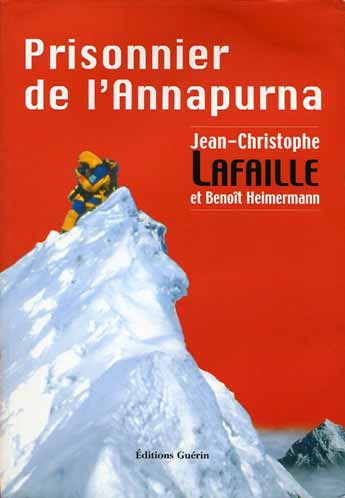

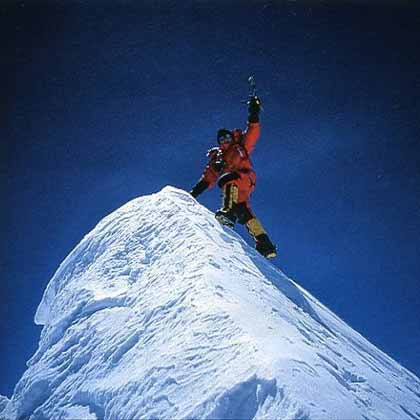

by Jean-Christophe Lafaille and Benoit Heimermann. Published 2003 in French. Lafaille describes his Annapurna attempts in 1992, 1995 and 1998 before his successful ascent in 2002. The front cover is Alberto Inurrategi on the Annapurna summit on May 16, 2002. There are 12 pages of colour and 12 pages of b/w photos.
The book starts with Lafaille's first Himalayan experience, an attempt with his friend and mentor Pierre Beghin on a new direct route on the Annapurna South Face in 1992 in alpine style with no Sherpa support or fixed ropes. On October 11, 1992 while descending in a storm at about 7100m tragedy struck. "The rope broke with a sharp snap: the 'friend' had released. Pierre fell without a cry. His gaze is printed in my memory forever. The look of someone who knows he will die." Beghin took both men's ropes and climbing equipment with him.
With great difficulty, Lafaille managed to climb down the 75 degree face to the pair's last bivouac site, where he found 20 metres of thin rope, allowing him to make short abseils down some of the hardest parts. At about 6600m Lafaille was struck by a falling rock, which broke his right arm. Disabled and helpless, he lay on a ledge for two days in the hope that a Slovenian team would rescue him. But they judged that a rescue attempt would be too dangerous. Lafaille continued down alone, downclimbing one-handed, and was utterly exhausted when he reached the Slovenian team's base camp.
Annapurna remained an obsession for Lafaille, and he returned to the mountain three times. In 1995 he made a solo attempt on the British line on the South Face, which failed at 7500m due to poor snow conditions. In 1998 he returned to the same route but abandoned the expedition when a young Sherpa was killed in an avalanche at 5700m. Although he again thought, 'I'll never come to this mountain again!', he did come back for his fourth attempt in 2002.
In 2002 Lafaille teamed up with Ed Viesturs, Veikka Gustafsson, Alberto Inurrategi, Jon Beloki, and Jon Lazkano to attempt an alpine ascent of the immense 7.5km East Ridge, a long traverse at over 7500m past the summits of Annapurna East (8026m) and Annapurna Central (8051m) to Annapurna (8091m). This route was climbed only once before, by Erhard Loretan and Norbert Joos in 1984. At Camp 4 (7300m), Ed and Veikka thought the risk was too great and decided not to continue the climb.
JC and Alberto continued, bivouacking the first night at 7400m, and the second night at 7900m below the East Summit. On May 16, 2002 JC and Alberto climbed on difficult, rocky, steep terrain for about five hours and reached the summit of Annapurna at 9:45 am. With Annapurna, Inurrategi became the tenth person to climb all 14 8000ers, all without bottled oxygen. "I myself am crying because the emotion is strong. ... Alberto holds the axe of his brother against his heart. ... I am on Annapurna and the reality is even more beautiful than my dreams."
The story is told in a very personal, immediate style, detailing JC's thoughts and feelings. The story of his descent of the Annapurna South Face after Beghin died is harrowing. The photos are excellent.

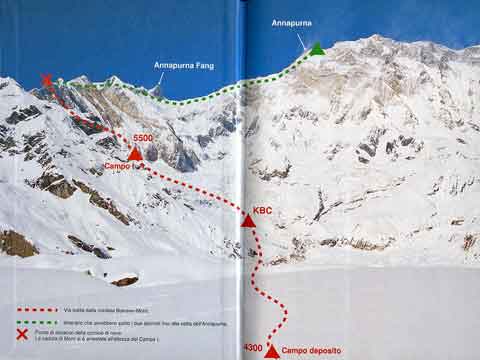


by Simone Moro. Originally published 2003 in Italian. Moro describes his tragic attempt to climb Annapurna in winter 1997, where he narrowly escaped death, but his companions Anatoli Boukreev and Dimitri Sobolev were killed in an avalanche. There are 26 pages of colour photos, and 3 bw photos.
The book starts with a brief autobiography, including his childhood and why he climbs. He briefly describes his speed ascent/descent of Fitz Roy (3441m) in 24 hours in 1996 and becoming friends with Anatoli Boukreev on Shishapangma in October 1997. In December 1997, Moro, Boukreev, and Sobolev attempted a bold new line on Annapurna, planning to climb to the Fang and then along the long ridge to the Annapurna summit.
On December 25 1997 just after noon, Boukreev and Moro were fixing ropes in a couloir at around 5700m when a cornice broke loose from a ridge above. Moro luckily survived the resulting avalanche, which carried him 800m back down the mountain to just above their camp. He immediately started looking for his two companions. "Analtoliiiiii..., Dimaaaaaa..., Anatoliiiiii. No response ... None." Moro looked around for 15 minutes but could only find a piece of backpack. "I did not know where to start. I was powerless." Unable to see or hear any signs of Boukreev or Sobolev, Moro descended to Annapurna base camp where he was flown by helicopter back to Kathmandu for surgery on his hands, which had been ripped down to the tendons during the fall.
I visited the memorial chorten to Anatoli Boukreev at Annapurna Base Camp in 2002. "In the mountains I celebrate creation. On each journey I am reborn." Even if you can't read Italian, the photos are excellent.

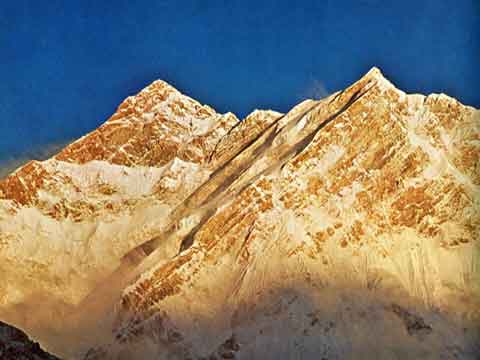

by Gianfranco Bini and Guido Machetto. Published 1980. Text in Italian and English. A large coffee-table type largely photographic account of the Autumn 1973 Italian expedition attempt on the Annapurna Northwest Spur, led by Machetto. There are 142 pages of colour photos.
The photos include local villagers, a monastery, their porters, the trek in, and Annapurna. The expedition reached 7000m, but were turned back by the fury of the monsoon, which lasted until mid-October, sweeping away practically all their equipment. Leo Cerruti and Miller Rava were killed on September 26, 1973 when a colossal ice and rock avalanche swept over Camp II.
The photos are very good. The text is very basic.
Annapurna is also featured in many general mountaineering books. Here are my favourites:



by Richard Sale, John Cleare ((Photographer). Published 2000. Highly recommended! The book details the exploration, first ascent, and other major ascents of all 14 8000m peaks, including spectacular photos.

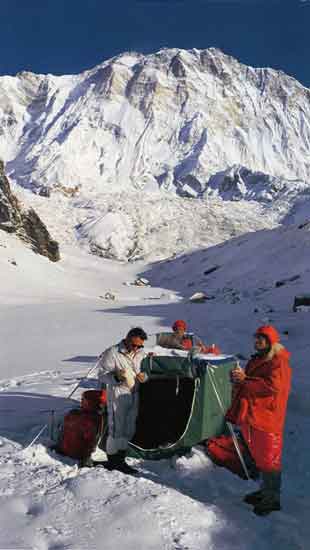


by Chris Bonington. This edition printed 1996. One of Michael Chessler's Best Mountain Photo Books. Famed British mountaineer Chris Bonington tells his autobiography mostly in photos in this coffee-table type book. The book features his early climbs in Great Britain; his alpine climbs in the Alps including Mont Blanc, the Eiger and Grandes Jorasses; his expeditions around the world including Paine in Chile, Baffin Island and the Blue Nile; and his expeditions both large and small to the Himalayas and the Karakorum - Annapurna II, Nuptse, Annapurna I South Face, Everest Southwest Face, Everest Northeast Ridge, the Ogre, K2, and Menlungtse.
Bonington devotes six pages to Annapurna II, and 10 pages on the Annapurna I South Face in 1970, with Dougal Haston and Don Whillans reaching the summit on May 27, 1970.
Bonington's photos are very good.



by Marco Bianchi. Published 2003 in Spanish. Although the title claims to be the 14 highest summits in the world, this beautiful, large-format photo book really focuses on the seven mountains the author climbed. The text is in Spanish, but the photos transcend language. The front cover is Shishapangma.
After attempts on Makalu in 1986 and Cho Oyu in 1989, Bianchi summitted seven of the 14 8000m peaks: Manaslu Sept. 28 1992 via Northeast Face, Broad Peak July 6 1993 via Normal route, Cho Oyu Sept. 18 1993 via West Ridge, Shishapangma Oct. 6 1993 via Southwest Face, Dhaulagiri Sept. 25 1994 via Northeast Ridge, Everest May 12 1995 via Northeast Ridge, and K2 Aug. 10 1996 via North Ridge.
There are 6 pages of the trek to Annapurna Base Camp and 4 pages of Annapurna North Face. The photos are excellent.
You can preview many of the photos at cuboimages.it by searching for Annapurna.
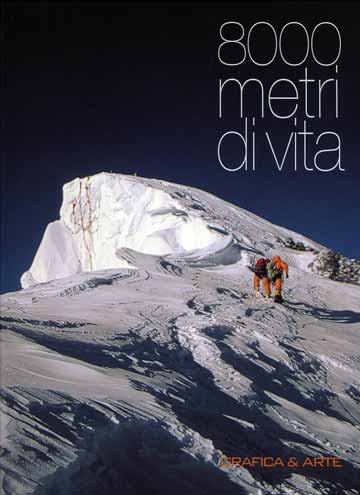
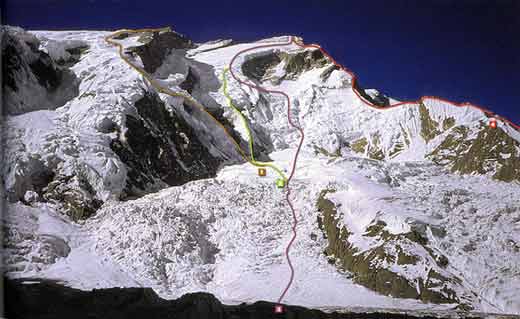
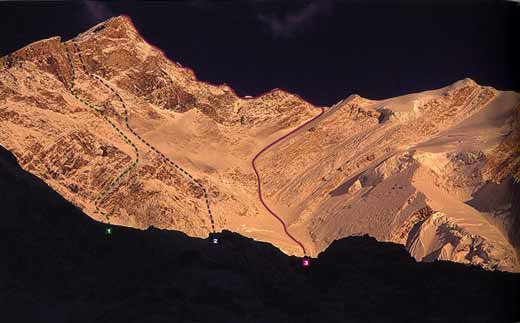

by Simone Moro. Published 2008. In Italian and English. This coffee-table size book features excellent photos from all 14 8000m peaks. Each 8000m peak has a brief history, a photo of each face showing the climbing routes, and lots of excellent photos.
There are 12 pages on Annapurna. Simone Moro, Anatoli Boukreev and Dimitri Sobolev attempted a winter climb of the southern wall of Annapurna in December 1997. An avalanche hit them on December 25, 1997 at about 6300m, burying Boukreev and Sobolev. The avalanche carried Moro 800m down to 5500m but he survived. Moro's attempt on the Annapurna North Face ended on May 29, 2004 at about 7900m due to stomach problems.
The photos and route diagrams are excellent.

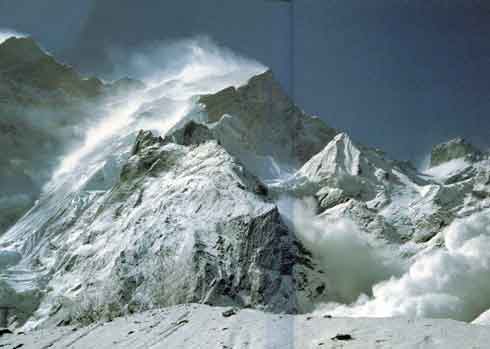

by Reinhold Messner. Published 1999. One of Michael Chessler's Top 100 Mountaineering Books. This book details Messner's ascents of all 14 8000m peaks documented with his photos. He also includes route diagrams and some basic history of the first few ascents. Messner was the first climber to summit all 14 mountains over 8000 metres in height, beginning with Nanga Parbat on June 27, 1970 and finishing with Lhotse on October 16, 1986. The cover photo is on the ascent of Kangchenjunga. The inside title page is on the summit of Nanga Parbat.
On April 24, 1985 Messner and Hans Kammerlander completed a route on the previously unclimbed Annapurna Northwest Face.
The photos are very good.

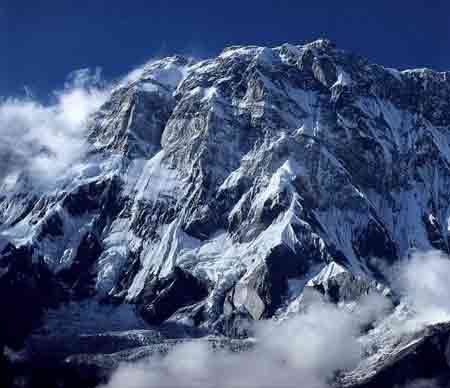

by Andy Fanshawe, Stephen Venables. Published 1996. This book briefly details 40 of the world's finest climbs on mountains in Pakistan (including Broad Peak, K2 and Nanga Parbat), India, Nepal and Tibet (including Annapurna, Shishapangma, Cho Oyu, Everest, Makalu and Kangchenjunga). Each climb is illustrated with many great photos, climbing routes, and summary statistics and information. Each area has an excellent overview map. The front cover is Kangchenjunga.
There are 6 pages on Annapurna South Face, a 1-page photo of Machapuchare, and 2 pages on Singu Chili (Fluted peak) South Ridge/West Face.

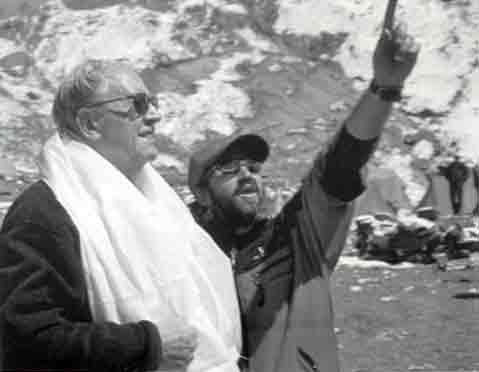


by Kiko Betelu. Published 1999. Text in Spanish. Spaniard Juanito Oiarzabal became the sixth mountaineer to summit all 14 8000m peaks when he reached the summit of Annapurna on April 29, 1999. This book reviews each of his 14 ascents with text, photos, and a route map. There are 65 colour photos and 42 b/w photos. With his ascent of Annapurna on April 27, 2010, Juanito holds the record for the most ascents of 8000m peaks with 24.
Annapurna is highlighted more than any other 8000m mountain with 52 pages, 19 colour photos, and 13 b/w photos.
The photos are very good. I especially liked the photos of Juan with Maurice Herzog.

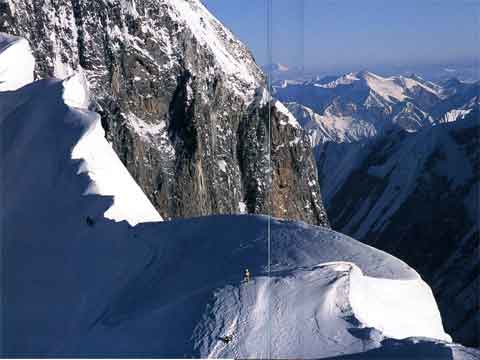

photographs by Ed Viesturs, text with Peter Potterfield. Released in early 2003, this book presents photographs with some basic text descriptions of Viestur's ascents of 11 of the 14 8000ers. After this book was published he reached the summit of Nanga Parbat in June 2003, Broad Peak in July 2003, and on May 12, 2005 he reached the summit of Annapurna, becoming the first American to reach the summit of all 14 8000ers, all without oxygen. The front cover is Manaslu.
Viesturs documents his first two attempts on Annapurna, the North Face in 2000 and the East Ridge in 2002. There are 20 pages on Annapurna. "The first time we went to Annapurna, in 2000, the objective danger was off the scale. ... (in 2002 the route) passed a dangerously avalanche-prone slope leading to the point of Roc Noir."
Ed's photos are excellent.
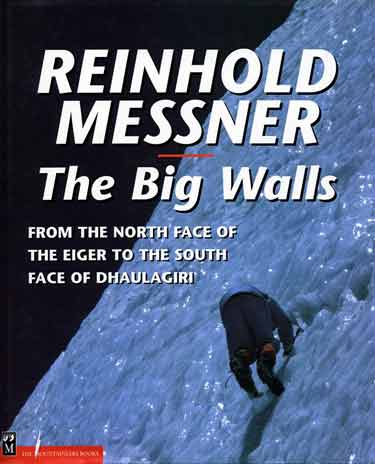
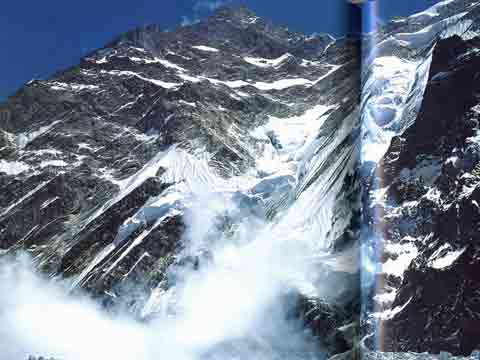


by Reinhold Messner. Revised in 2001. Messner briefly details the big mountain walls in the world in the Himalayas, the Karakorum, the Alps, South America, Alaska and the Caucasus.
It includes the cover and two photos from Messner's ascent of Annapurna's North-West Face, and a 1-page photo and two pages on climbing Annapurna's South Face.
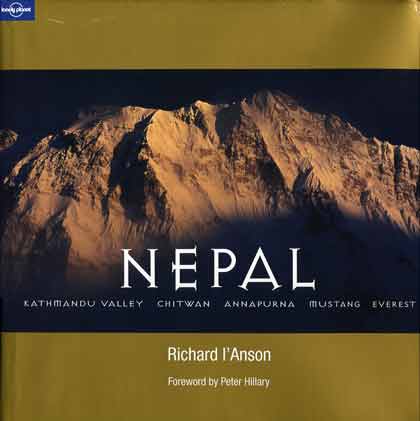
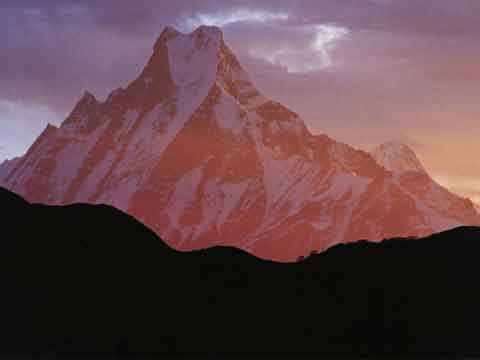
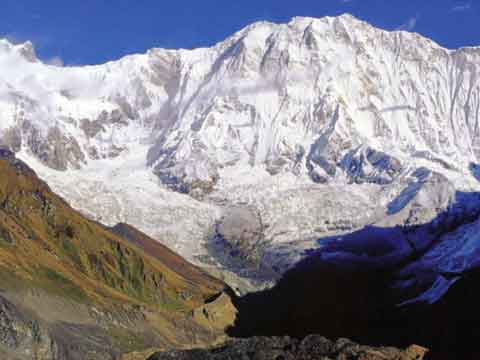

by Richard I'Anson. First published 2007. A large coffee-table type book featuring over 400 photos from renowned photographer Richard L’Anson. Chapters include Kathmandu and Kathmandu Valley (112 pages), Chitwan (20 pages), the Annapurna Circuit and Sanctuary (54 pages), Upper Mustang (20 pages), and the Mount Everest Khumbu region (51 pages). The front cover is Annapurna South Face.
The Annapurna chapter begins with Pokhara and Sarangkot. The views from Dhampus, Ghandruk and Poon Hill precede the photos from the Sanctuary itself. The Annapurna Chapter ends with photos from Pisang , Braga, and Manang, ending at the Thorung La. Mountains featured include Annapurna I, Machapuchare, Dhaulagiri, Annapurna South, Annapurnas II, II and IV, Himalchuli, and Gangapurna. Lower Mustang in the Mustang chapter is actually part of the Annapurna Circuit, and features Muktinath, Jharkot, Kagbeni, Jomsom, and Marpha. Part of the Mustang chapter features Upper Mustang from Kagbeni to Lo Manthang. Villages featured include Chuksang, Chele, Ghemi, Charang, Lo Manthang, Drakmar, and Tama Gaon. There are two excellent photos of Dhaulagiri, one from Poon Hill and the other from Muktinath.
This is my favourite Nepal photo book. It features all of the main tourist areas. The photos are spectacular.
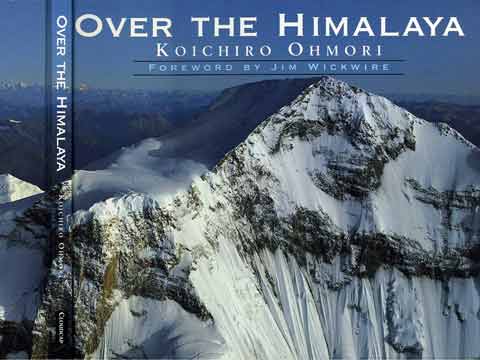


by Koichiro Ohmori. Published 1998. One of Michael Chessler's Best Mountain Photo Books. This book features 44 spectacular 2-page aerial photos of the 8000m Nepalese mountains - Kangchenjunga, Makalu, Everest and Lhotse, Cho Oyu, Manaslu, Annapurna and Dhaulagiri (cover) - and several others, including Jannu, Nuptse, and Ama Dablam. Route diagrams and some basic history of the first few ascents are also included. The front cover is Dhaulagiri.
There are seven 2-page photos of the Annapurna region - Annapurna I is in 4 of the photos, Machapuchare in 4, and Annapurna II in 3.

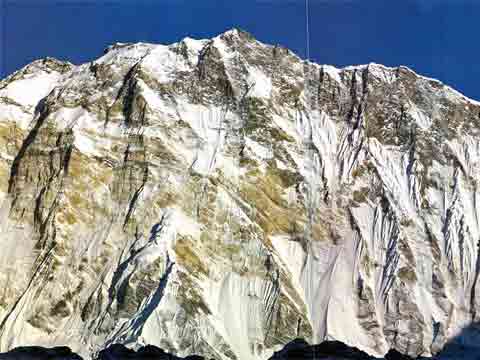

by Shiro Shirahata. Published 1983. One of Michael Chessler's Best Mountain Photo Books. A large, heavy quality paper, coffee-table type book featuring 115 spectacular photos, over half double-pages, of the 8000m Nepalese mountains - Kangchenjunga, Makalu, Everest and Lhotse (cover), Cho Oyu, Manaslu, Annapurna, Dhaulagiri - and many others, including Jannu, Nuptse, and Ama Dablam.
There are 25 pages with 15 photos of the Annapurna region - two double-page photos of Annapurna I's South Face. Other photos include Annapurna II, III and IV, Gangapurna, and Machapuchare.

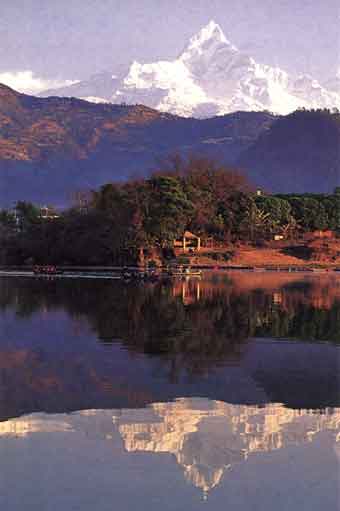
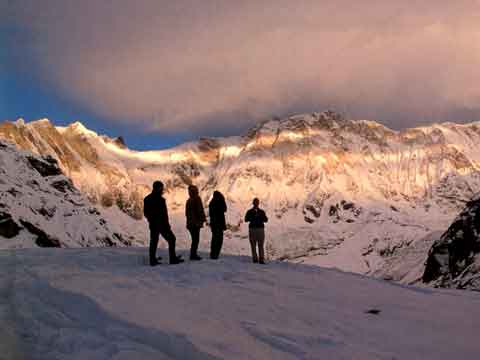

by Andrew Stevenson. Published 2002. The author of the Annapurna Circuit Himalayan Journey travelogue produces a photographic journey of the Annapurna Circuit and Sanctuary and Upper Mustang, with an overview of each section of the trek.
Stevenson provides a good description of the trek and includes very good maps. The photos are very good, especially of the Nepalese people. I would have preferred a few more photos of the mountains.
This is a perfect companion book to the his Annapurna Circuit: Himalayan Journey book and to the Trekking Guides, enabling you to visualize what you will experience on the trek.
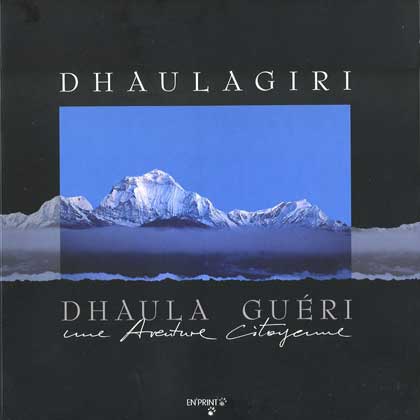
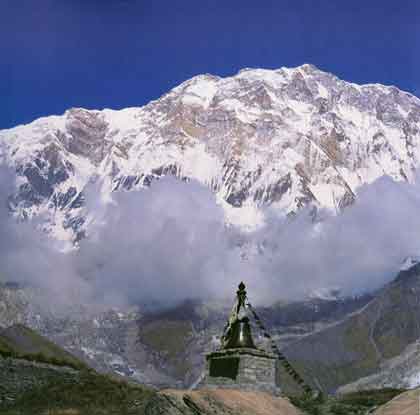

by Breffni Bolze, Lionel Fargeix, Remi Deluzarche, Cyril Kotenkoff, Matthieu Constantin, Francois-Xavier Cierco, David Amans, Carron Scrimgeour. Published 2003 in French. This is the story of a group of eight young mountaineer friends who decided to clean up Dhaulagiri North Base Camp from the waste left behind by mountaineers and trekkers.
In 2001 they traveled to Kathmandu and trekked to the Annapurna Sanctuary and Dhaulagiri North Base Camp. In 2002 they returned to Kathmandu and trekked to Hidden Valley and Muktinath. They burned 500kg of cartons, textiles and plastics; transported 122kg of metal and 80kg of glass to Pokhara to be recycled; and 20kg of batteries to France to be recycled.
Even if you can't understand French, the photos are excellent.

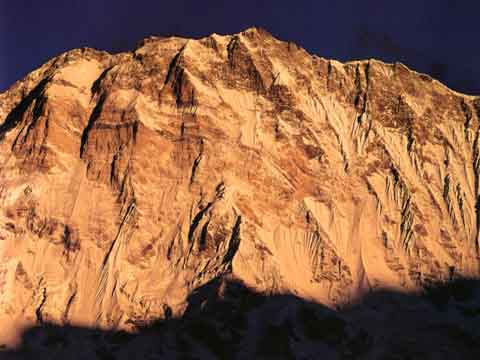
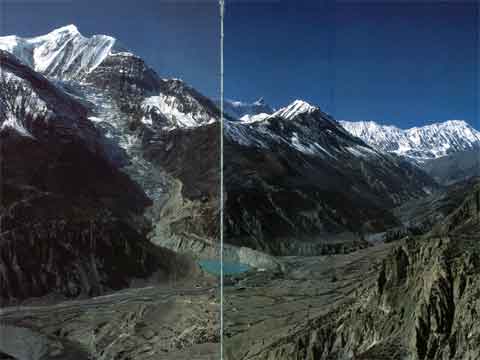

by David Paterson. First published 1990. This large coffee-table photo book features Kathmandu and the author’s treks from Lamosangu to Lobuche Base Camp and Everest in 1979, the Annapurna Sanctuary in 1979, Rolwaling and the Tesi Lapcha pass to Gokyo in 1981, the Annapurna Circuit in 1984, Ganesh Himal in 1987, the Arun Valley from Hille to Makalu in 1988. The front cover is Ama Dablam.
The photos are very good, especially Annapurna South Face at sunrise, Annapurnas III, Ganagapurna, the Grande Barriere, and Dhaulagiri.
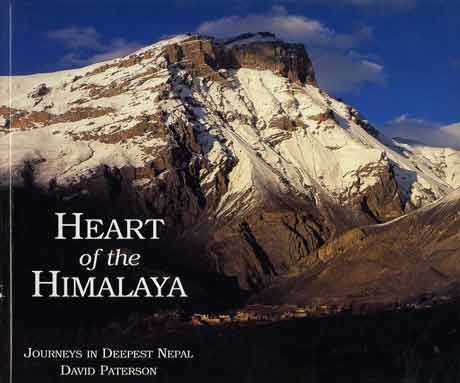
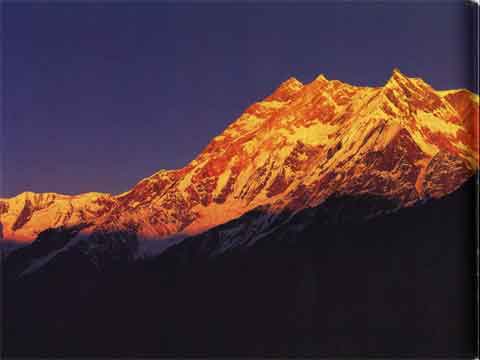

by David Paterson. First published 1997. Medium-sized soft cover book features the author’s treks to Kangchenjunga and Jannu in 1992, Kali Gandaki Valley and the Thulobugin Ridge between Dhaulagiri and Annapurna in 1996. This book also features the treks from Nepal: The Mountains Of Heaven, with some new photos and some photos the same. The front cover is the Muktinath Himal.
You can see some of David Paterson's photos at his website wildcountry.uk.com.
The photos are very good, especially Annapurna North Face and Dhaulagiri from the Thulo Bugin Ridge high above the Kali Gandaki Valley.

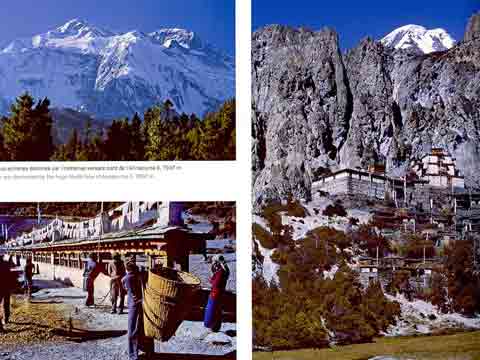

by Laurent Doldi. Published 2006. In French and English. A large soft-cover photo book detailing 10 Himalayan treks: K2 Base Camp (12 pages. 23 photos), Ladakh to Zanskar (16 pages, 38 photos), Jeep tour in Kinnaur Spiti and Ladakh (12 pages, 32 photos), the Sources of the Ganges in India (14 pages, 30 photos), Dolpo (18 pages, 36 photos), Around Annapurna (22 pages, 45 photos), Helambu and the sacred lakes of Gosainkund (16 pages, 29 photos), Rolwaling Valley in winter (18 pages, 37 photos), Everest Base Camp and Gokyo Lakes (20 pages, 41 photos), and Kangchenjunga Base Camps in Nepal (21 pages, 44 photos). Each chapter starts with a very brief overview including a map and altitude profile. The front cover is K2. There are 360 colour photos.
This is very good companion book to a trekking guide, enabling you to visualize what you will experience on a trek. The photos are very good.
For news on Annapurna expeditions, I check the following regularly:
There are many informational websites, with my favourites being:
There are a few expedition and many trekking websites, with my favourites being:
I thoroughly enjoy reading other people's travelogues and looking through their photos. Here are my favourites:
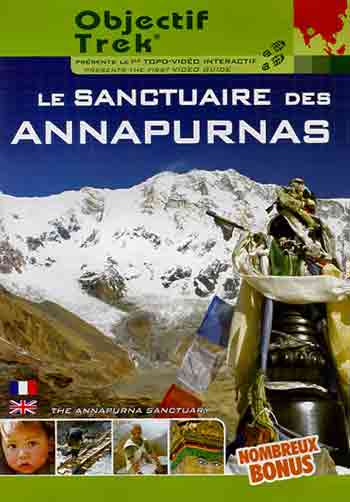

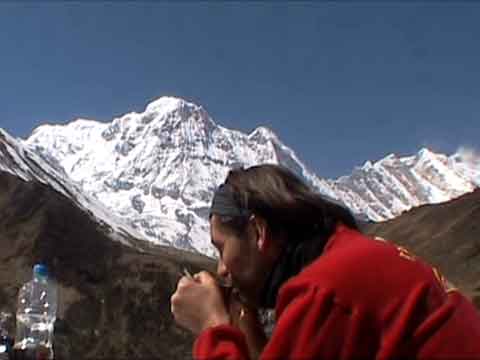

by Daphne Beauvais. Released 2007. 60 minutes. In French and English. This video follows trekker Pascal Varambon, guide Loxman, and porter Sun Bahader on their trek to the Annapurna Sanctuary in March 2006. Their route was Phedi, Dhampus, Landrung, Sinuwa, Deurali, Annapurna Base Camp, Doban, Chomrong, Syauli Bazar, and Naya Pul. A variation from Chomrong to Tadapani to Ghorapani to Poon Hill to Naya Pul is also briefly shown. The weather was perfect.
"There is something so magic about this itinerary, which in just five days takes you from a sub-tropical climate and the lush green scenes of forests and terrace plots to freezing summits and tough, barren mountain landscapes that are the backdrop to some of the greatest mountaineering adventures ever. From the very first day, you can make out these distant peaks with their magical names such as Dhaulagiri, Machapuchare, and Annapurna. And each day takes you closer to these stars.
There are 30 minutes of bonus features. The first (9 minutes) details the preparations for the trek, including the itinerary, permits, altitude sickness, and clothing and boots. The second (9 minutes) features Kathmandu sights of Durbar Square, Swayambhunath, Boudhanath, Pashupatinath with scenes of the February Shivaratri festival, Bhaktapur, and Pokhara. The other bonus features include an overview of the Himalayan Travel Bureau (6 minutes) who organized their trek, and a slide show (6 minutes) of photo images of Kathmandu and the trek.
This is a perfect trekking video. It clearly shows what you will go through, the trekking paths, the ups and downs, the villages and people, the lodges, and the weather. It is expertly filmed and well paced with excellent narration and background music.
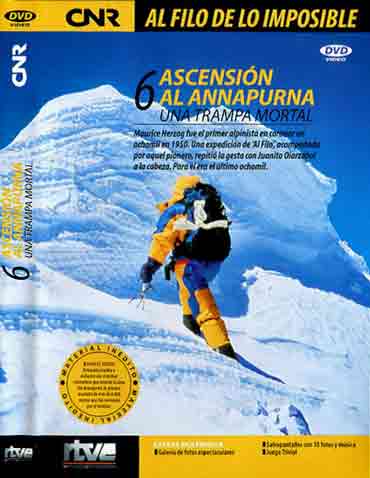
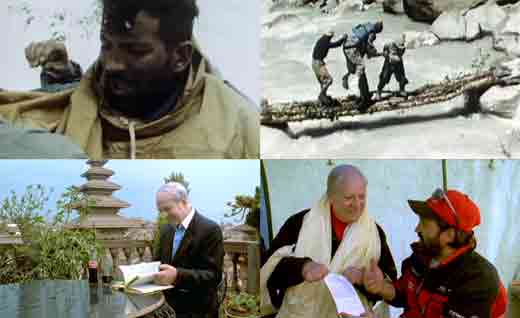
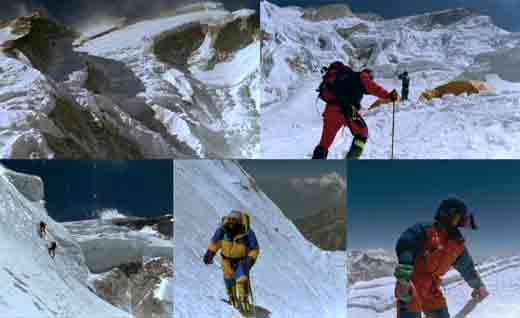
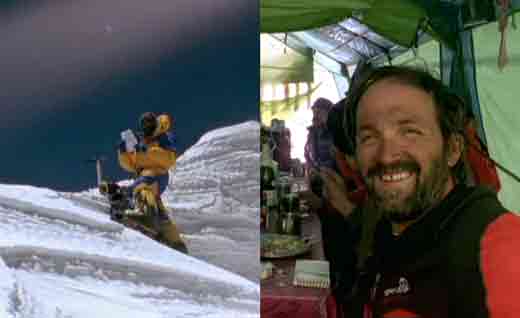

by Sebastian Alvaro. Al Filo De Lo Imposible, Spanish TV 2000. 56 minutes. Filmed in 1999. This film documents Spanish climber Juanito Oiarzabal as he attempts to finish the 14 8000m summits on Annapurna along with other climbers Juan Vallejo, Ferran Latorre, and Eneko Pou. It includes studio interviews with Juanito, Claude Marin, Marianne Terray, and Maurice Herzog. Extras include an interview with Maurice Herzog (39 minutes), de Cerro a 8000: Grandes epopeyas en al Himalaya: Annapurna (25 minutes, Spanish TV 2000) - a longer version of what happened on the first ascent of Annapurna in 1950 than on the main video.
The film opens with Maurice Herzog who, along with Louis Lachenal, was the first person to climb any 8000m peak when they climbed Annapurna on June 3, 1950, visiting Kathmandu including Boudhanath and turning the prayer wheels with this amputated fingers at Swayambhunath. Maurice opens a copy his book Annapurna, the best selling mountaineering book in history, and writes a message on the last page
It then switches to the climbing team as they trek with the porters passing verdant green fields, waterfalls, villages and the local people. They climb to Shepherds Kharka with a spectacular view of Dhaulagiri and Tukuche Peak, and then cross the Top Of The World Ridge with perfect views of Annapurna North Face before descending into the Miristi Khola and continuing to base camp. After the puja they climb above base camp and see the full view of the north face. Maurice Herzog then arrives at base camp in a helicopter, where he presents Juanito with the message to take to the summit.
They climb to camp 1 and continue up sold ice walls to camp 2 set beneath an enormous serac, and then return to base camp. Juanito picks up the message given to him by Maurice Herzog and climbs back up to camp 1 and camp 2. Juanito climbs high on Annapurna with views to Dhaulagiri, and on April 29, 1999 Juan Vallejo and Juanito Oiarzabal reach the summit of Annapurna. Juanito thus became the 6th mountaineer to climb all 14 8000m peaks. Juanito takes out the Maurice Herzog message and throws it to the wind. They descend to a party at base camp.
Interspersed with the 1999 expedition is a footage from the first ascent of the Annapurna by the 1950 French Expedition, including the initial base camp at Tuckche, the local people singing and dancing, exploring the mountains, trekking to base camp, and climbing above Annapurna base camp. Maurice Herzog and Louis Lachenal the stagger back at camp 2 showing their frostbitten fingers and toes, are lowered to base camp and then are carried out on the backs of porters.
This is really two videos in one - one is an excellent film of the trek to base camp and the climb of Annapurna in 1999, and the other is a tribute to Maurice Herzog and the first ascent of Annapurna in 1950. The video quality is very good. I especially enjoyed the footage from the first ascent in 1950.
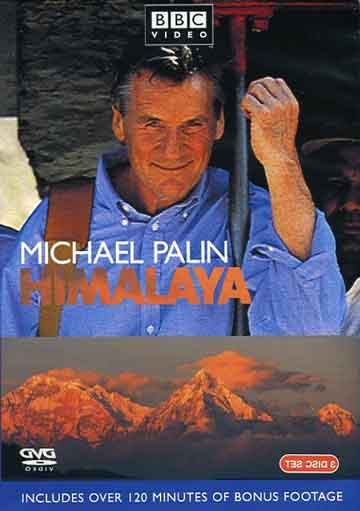
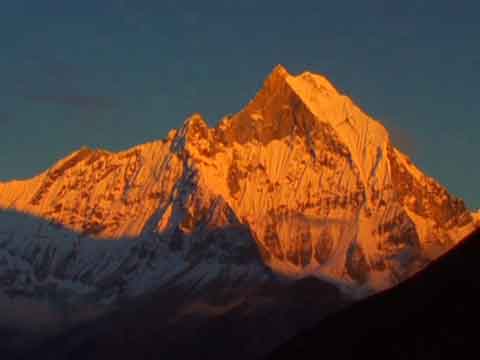
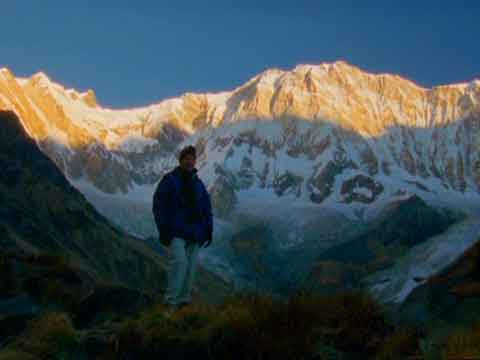

Directed by John-Paul Davidson and Roger Mills Shown on TV in 2004. Six episodes. 352 minutes. BBC. Extras include 31 minutes of interviews with Michael and 124 minutes of deleted scenes. Episode 3 Annapurna to Everest (59 minutes plus 29 minutes of deleted scenes) features Annapurna (30 minutes plus 12 minutes of deleted scenes), Kathmandu, and Everest North Base Camp.
Annapurna opens with a microlight flight along the massif. Palin treks to a village with a British commander of the Gurkha regiment to hold a recruitment test. They encounter the Maoists, who take the recruiting officer and three others off into the forest, releasing them two days later. Michael then treks to Annapurna South Base Camp, meeting other trekkers and a beautiful lodge owner on the way. He treks up and down the trails, seeing how the porters practically scamper along the trail. As they climb higher to Machapuchare Base Camp, Michael doesn't feel too well with a sore throat and feeling the effects of the higher altitude. They continue their trek to Annapurna South Base Camp, with views of Annapurna I, Annapurna South and Machapuchare. There is a perfect sunset on Machapuchare, followed by a perfect sunrise on Annapurna I and Fang.
The views of Annapurna and Machapuchare are spectacular. The trekking scenes are very good, showing the the porters and villagers, the paths, the weather, and the effects of altitude. Beautifully filmed. Nicely paced. Michael Palin is very entertaining.
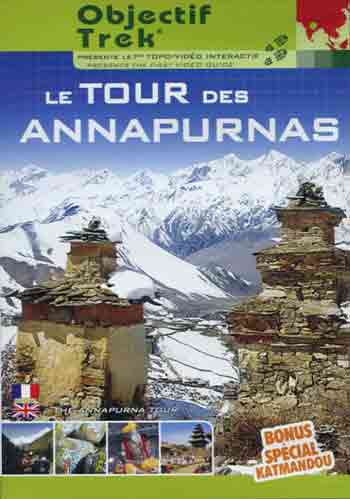
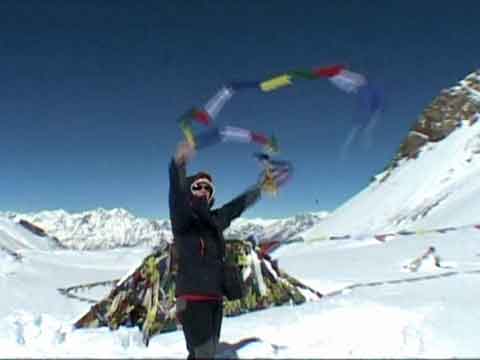
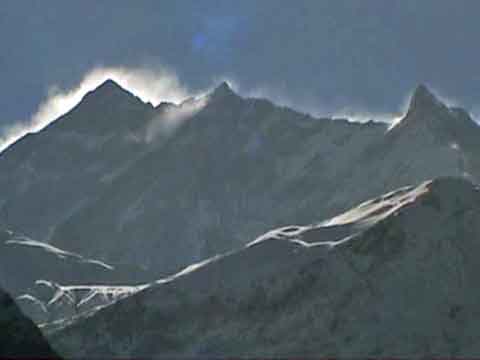

by Pascal Varambon. Released 2006. 100 minutes. In French and English. This video follows trekker Daphne Beauvais, guide Serre, and porter Sunbaader on their trek around Annapurna in March. They started by taking the bus to Besisahar and then trekking in heavy rain first to Ngadi, and the following day to Jagat. The sun finally arrived as they trekked to Dharapani, and again it was sunny as they enter Buddhist country on the way to Chame with mountain views of Annapurna II and Manaslu. The cold and snow returned as they trekked to Pisang, and the next day on the high route via Ghyaru and Ngawal to Manang. On their day off they visited Braga Gompa under mostly cloudy snowy conditions. The sun arrived briefly on the trek to Thorong Phedi followed by snow.
It was extremely cold but brilliantly sunny as they trekked to the high point of Thorung La (5400m) followed by a dreadful descent in deep snow to Muktinath. The weather now turned perfect. They took a day off in Muktinath to visit the Hindu and Buddhist shrines and the village of Jharkot with views of Dhaulagiri in the distance. They stopped at Kagbeni before facing the winds on the way to Jomsom, followed by a short day to Marpha to enjoy their apples, and then he next day to Kalopani with a rare view of Annapurna Northwest face. After a night at the hot springs of Tatopani, there was a hot steep ascent to Ghorapani and a pre-dawn climb to see the sunrise of Dhaulagiri and the Annapurna massif from Poon Hill, and then a steep descent to Naya Pul and the end of the trek.
There are 29 minutes of bonus features. Katmandou et sa Vallee (Kathmandu and Valley) (14 minutes) features the people of Kathmandu and the sights of Durbar Square, Swayambhunath, Boudhanath, Pashupatinath with scenes of the February Shivaratri festival, and Bhaktapur. Other bonus features are the preparations (9 minutes) for the trek, including the itinerary, culture, altitude sickness, permits, responsibility for the environment, hiring a guide and porters, clothing and boots, lodges, toilets and showers; and an overview of the Himalayan Travel Bureau (6 minutes) who organized their trek.
This is a perfect trekking video for the portion from the Thorung La to the end. The portion from the beginning to the Thorung Phedi is hampered with bad weather, and therefore does not show the scenery and mountain views very well. It clearly shows what you will go through, the trekking paths, the ups and downs, the villages and people, the lodges, and the weather. It is expertly filmed and well paced with excellent narration and background music. The bonus on Kathmandu is excellent, showing the main tourists sights, and the Shivratri scenes are spectacular.

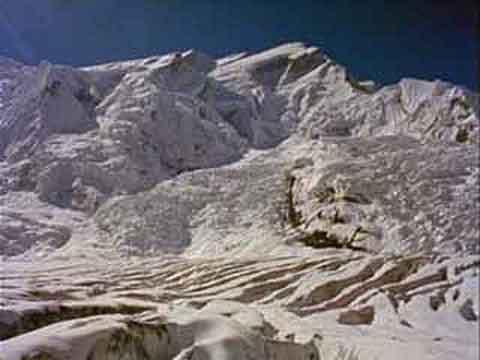

This 42-minute film from 1979 was digitally remastered in 1998. It tells the story of the 1978 American Woman's Himalayan Expedition to Annapurna I, led by Arlene Blum, and featuring their famous t-shirt slogan "A Woman’s Place Is on the Top”.
The film follows the team of ten women climbers as they trek along narrow dangerous shepherd's paths to base camp with good scenery, meeting villagers, and treating porters for various health problems. There are brief profiles of each climber, scenes of smiling and camaraderie, and a surprisingly frank scene of dissent and painful conversations among the climbers. They establish camps on the North Face of Annapurna, ascend the steep and dangerous Dutch Rib, having to retreat twice due to storms and avalanches.
On October 15, 1978 Vera Komarkova, Irene Beardsley, Chewang and Mingma made it to the summit of Annapurna. The film crew at Camp I captured the summit using a telephoto lens. Happiness quickly turned to tragedy when the second summit team Vera Watson and Alison Chadwick died the next day, falling on their way to Camp V.
I liked this video, well filmed, very honest and refreshing.
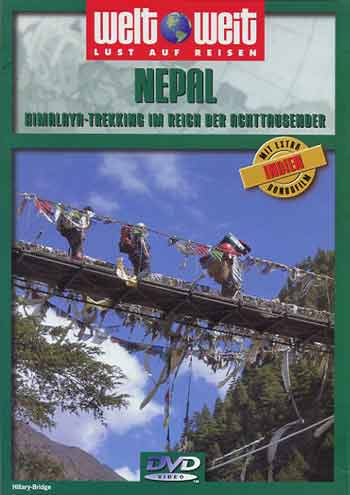



Welt Weit. 20 minutes. 2005. In German. Trekking with DAV Summit Club. This DVD also has the trek to Everest Base Camp (40 minutes), and a bonus feature visiting Calcutta, Darjeeling, and Orissa in India (27 minutes). The film starts with the flight from Kathmandu to Pokhara, with views of the mountains. In Pokhara they take a boat ride on the lake, and climb above Pokhara for mountain views like Machapuchare and Annapurna South on the horizon. They then fly to Jomsom and trek to Kagbeni and Jharkot. They are joined by both Hindu and Buddhists pilgrims as they complete their journey at holy Muktinath.
Even though the video is in German, it is easy to know where they are. The filming is very good. The views of the lake next to Pokhara and the mountains like Machapuchare and Annapurna South on the horizon are spectacular.
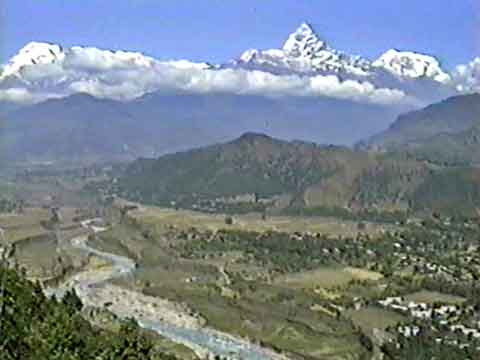
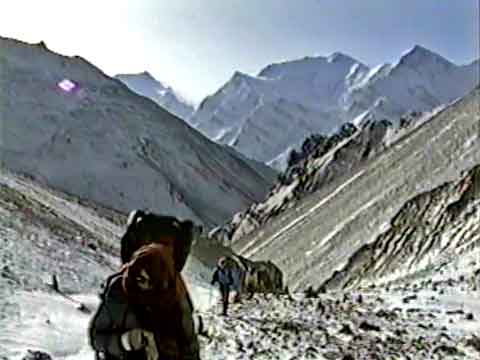

by Steve Kocsis and Cristina Della Rosa from Kailash Video. Released 1993. 90 minutes. Filmed in October and November. This home video starts with the bus trip from India to Pokhara and Dumre, where the trek begins. The trek goes via Chame and Braga to Manang, where they climb above the village to visit a hermit lama for a blessing. Their trek over the Thorung La is cold and a bit snowy. They descend to Muktinath for a brief visit, and then continue to Marpha and Tukuche, with excellent views of Dhaulagiri. And then on to Tatopani, Ghorepani and Ghandruk, with excellent views of Annapurna South and Machapuchare. They finish in Kathmandu with scenes of Bhaktapur, Pashupatinath, and Boudhanath.
The villages, scenery, trails and mountains views are very good. The narration is very good, detailing the different sights and providing many travel tips like the length of your trekking day, the lodges and villages, being a responsible trekker, dealing with altitude sickness, etc. Unlike many home movies, the camera work is fairly steady with slow pans and very good audio quality, although the colour is slightly washed out. The film editing is generally good, with only a few quick edits. The film could be slightly tighter, with a few less villages, lodges and trail scenes.



by Rick Hunt. 42 minutes. Filmed in October and November 2002. The Annapurna Trek For Literacy is a home video, which starts with a few scenes in Kathmandu and then features visits to three schools sponsored by John Wood, the founder of Room To Read. John speaks to the school children, who echo back Namaste to him.
The film then follows a group of trekkers around the Annapurna Circuit from Besi Sahar to Pisang , the high road of Ghyaru and Ngawal to Manang, crossing the Thorung La, and finishing at Beni.
Like many home movies, the camera work is a bit shaky with some fast turns, and only good audio quality. You can even hear Rick laughing at times as he films the trekkers mugging for the camera. The school scenes were heart warming, The trek to the Thorung La is fairly well documented, but the rest is not. There is no Muktinath, no Kagbeni, no Dhaulagiri, no Annapurna, and no Pokhara.